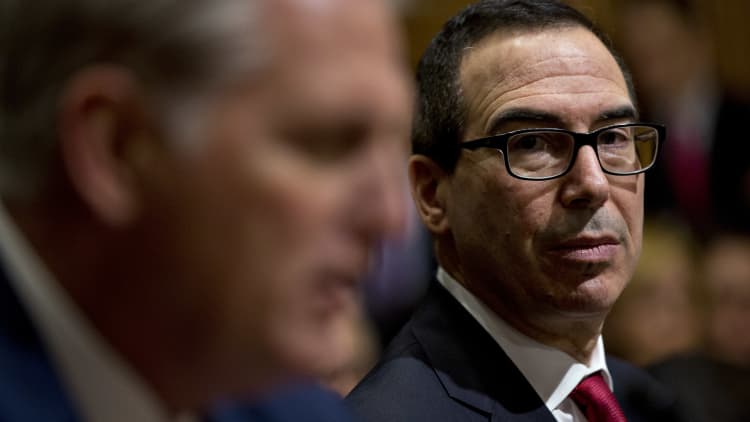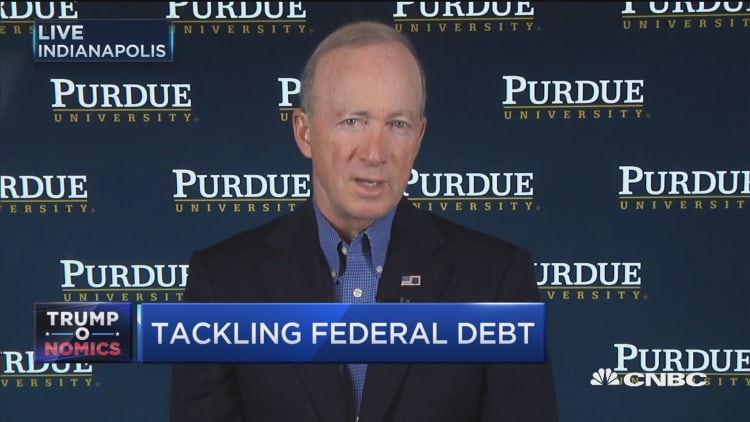
While Wall Street celebrates the Dow hitting 20,000, there is another "20" looming that could carry significantly darker overtones.
The U.S. is just weeks away from passing the $20 trillion mark in total public debt outstanding — the "national debt," as it is more widely known.
Though general concern about containing debt and deficits has waned as the nation has looked for ways to stimulate the sluggish, post-recession economy, that $20 trillion milestone could grab at least some attention.
"While the party hats are out for 20K on the Dow, that $20 trillion in debt is really salient," said economist and debt hawk Michael Pento of Pento Portfolio Strategies. Pento has been predicting a bond market crash that would come with a collapse in demand and the weight of eventually rising rates that will push up the cost to finance American debt.
Debt nearly doubled under former President Barack Obama, who presided over it mushrooming from $10.6 trillion to $19.9 trillion by the time he left office last week. Though he's only been in office for less than a week, President Donald Trump has seen the debt rise another $2 billion.
It has become all too commonplace to borrow not for productive investments or for wherever we are in the business cycle ... but because people don't want to pay the bills and have found it politically expedient not to do so.Maya MacGuineaspresident, Committee for a Responsible Federal Budget
The current total as of Monday, in exact numbers, is $19,949,687,366,998, according to the Treasury Department. With the U.S. expected to run a budget deficit in 2017 of $559 billion, the $50.3 billion or so needed to break $20 trillion should happen relatively soon.
"The massive debt is really a reflection of the unwillingness of our political leaders to make any tough decisions or deal with trade-offs," Maya MacGuineas, president of the Committee for a Responsible Federal Budget, said in a phone interview. "It has become all too commonplace to borrow not for productive investments or for wherever we are in the business cycle ... but because people don't want to pay the bills and have found it politically expedient not to do so."
There are two numbers at play when talking about the national debt — debt held by the public and intragovernmental holdings. The latter debt includes money the government essentially owes itself, like when the Treasury borrows from other funds to make entitlement payments. That total is about $5.5 trillion, while the public debt, which includes all other government debt, is $14.4 trillion.
How much significance the $20 trillion breakthrough will have depends on perspective.
On one side, there's the argument that the debt and deficits don't matter now because interest rates are low and the deficit only amounts to 2.9 percent of gross domestic product. On the other side are the hawks who believe that while financing costs are cheap at this point, the current trajectory ultimately will be unsustainable.
In a report released this week, the Congressional Budget Office warned that current spending is on track to take debt held by the public to nearly $25 trillion by 2027, or 89 percent of GDP. The deficit is the amount of money the government spends each year against what it takes in, while the debt is the cumulative amount the government borrows to finance its operations.
"Such high and rising debt would have serious negative consequences for the budget and the nation," the CBO said in a report, adding that "the likelihood of a fiscal crisis in the United States would increase."
When that tipping point starts to happen is unclear.
While the $20 trillion threshold could generate some attention when it is broken, more attention could come in 2018 when the debt-to-GDP ratio starts "pivoting," said Ernie Tedeschi, policy economist at Evercore ISI.
"2018, according to what the CBO has been telling us over the past couple of years, is when you start to see on one hand the real burden of demographics on entitlement spending on things like Social Security, Medicare and Medicaid come into play, and when you see the recovery in tax revenues from the recession ... be for the most part complete," Tedeschi said.
The Trump factor
The political climate also complicates the picture.
The debt climb during Obama's term came with economic growth that clocked in at only around 1.6 percent. Trump has promised stimulus spending that many economists believe will accelerate growth, but also could worsen the debt burden. (Trump has pledged that growth plus spending cuts elsewhere will counterbalance spending increases, and therefore the debt burden will not increase.)
At the same time, the Federal Reserve's policy of keeping interest rates low during the past eight years kept debt costs down. But the Fed plans to get more aggressive in pulling back from its ultra-low rates stance this year, which likely will drive up the government's debt costs.
"Donald Trump has said that entitlements are off the table and he doesn't want to cut defense spending," Pento said. "In a world of skyrocketing debt and deficits and central banks that will be selling, who's left to buy? No one is really talking about how high interest rates could go and how artificially depressed they are if you look at them in historic terms."
Even with low rates, the U.S. paid $432 billion in debt service in fiscal 2016 and already has shelled out $139.1 billion for the new fiscal year that started in October. Total debt financing costs during the Obama years came to about $3.3 trillion, according to the Treasury.
One rule of thumb is that each quarter-point rate hike translates into $50 billion more in debt service. So rising yields, even under the Fed's relatively muted forecasts, could add hundreds of billions to debt costs.
"Some of the numbers become so eye-popping that we can't ignore them. But if we wait too long, it will be too late to make these choices responsibly," MacGuineas said. "If we do wait until we're forced by a bad economy or our creditors to make changes, those changes will be so much more painful and the economy will go through a much more massive downturn."



